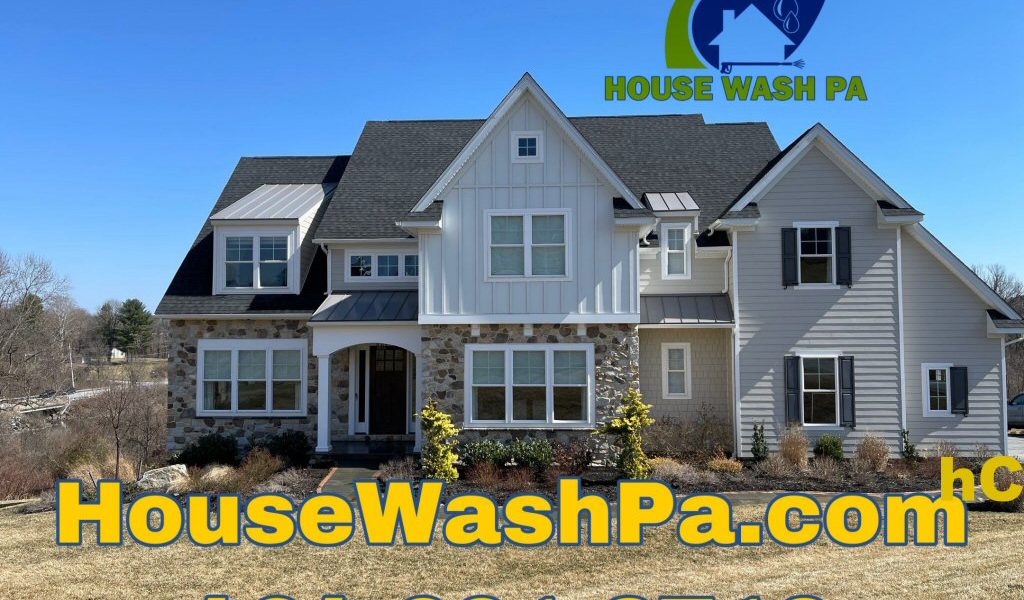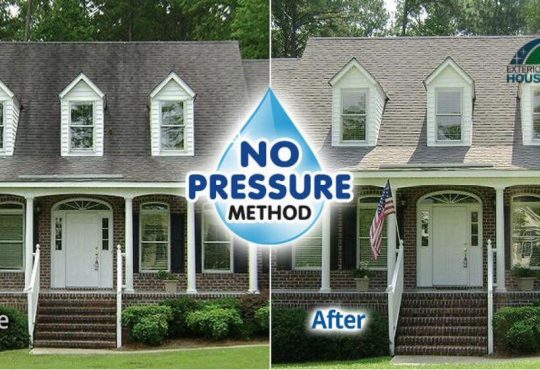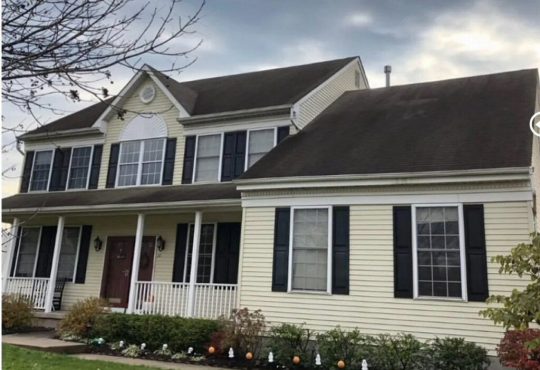
Pressure washing your home
Pressure washing your home
Pressure washing your home is an efficient and effective way to keep the exterior of your home in pristine condition. In HouseWash, PA, where the weather can take a toll on your home, routinely Pressure washing your home is necessary. Nevertheless, it is very important to approach this task with care and focus on safety above all else. This extensive guide will stroll you through the entire process, making sure a clean and revitalized home while keeping you and your environment protected.
I. Intro to Pressure Washing Your Home
A. The advantages of pressure washing your home
Regularly Pressure washing your home provides numerous advantages to house owners in HouseWash, PA:
- Eliminating persistent dirt, gunk, mold, and discolorations from different surfaces such as siding, roofs, decks, and driveways.
- Safeguard your home‘s outside surfaces by avoiding the accumulation of harmful impurities that can cause damage over time.
- Improve curb appeal and increase the worth of your property with a well-maintained look.
- Prepare surface areas for painting or staining to make sure optimal adhesion and longer-lasting results.
B. Why security must come first when pressure washing your home
While pressure cleaning is an effective cleansing approach, it utilizes high-pressure water jets that can be unsafe if not managed correctly. Disregarding security precautions can lead to prospective injury, property damage or perhaps legal liability. This guide stresses the importance of taking the needed steps to ensure safe and successful pressure cleaning.
C. Summary of the guide to Pressure washing your home
This comprehensive guide covers all aspects of power cleaning your home in HouseWash, PA, from getting the ideal devices to troubleshooting and maintenance. By following the steps described in this guide, you will be geared up with the understanding and tools to accomplish this task safely and efficiently, eventually leaving you with a clean and refreshed home without jeopardizing your wellness or that of those around you.
II Preparing for Pressure washing your home
Proper preparation is the crucial to safe and effective power cleaning. Before you start, it is essential to get the right equipment, inspect the location and test the surfaces.
Inspect the area before Pressure washing your home
Before you begin Pressure washing your home, check the area thoroughly:
- Clear away furniture, toys and other products: remove any items that could be harmed or provide a tripping danger.
- Cover or eliminate sensitive items: Safeguard plants, lamps and other delicate items by covering them with tarpaulins or removing them from the location.
- Check for prospective risks: Look for prospective dangers such as loose siding, overhanging power lines or unstable surface areas that could position a danger during Pressure washing your home.
Examine the surface areas
It is always an excellent idea to test the pressure washer on an inconspicuous area first:
- Evaluate an unnoticeable location first: begin with a small, unseen area to evaluate the result of the pressure and adjust as necessary.
- Adjustpressure and distance as required: Explore various nozzles, pressures and distances to find the maximum settings for each surface without causing damage.
III Power washing techniques
To achieve effective cleansing results while reducing the threat of injury or residential or commercial property damage, the correct method is important. This section covers the most crucial aspects of safe and effective power washing strategies.
A. Comprehending PSI and GPM
Two crucial terms you will encounter when pressure washing are PSI (pounds per square inch) and GPM (gallons per minute). PSI describes the water pressure generated by the pressure washer, while GPM refers to the water circulation rate. Greater PSI and GPM values normally imply more cleaning power, however also increase the danger of surface area damage if not used properly.
B. Picking the right nozzle and pressure
- Mild washing vs. high pressure: For delicate surfaces such as wood or stucco, mild washing with lower pressure and wider nozzle angles (25°& deg; -40 & deg;-RRB- is advised. Harder surface areas such as concrete or vinyl siding can tolerate higher pressure and narrower nozzle angles (0°& deg; -15 & deg
- ;-RRB-. Nozzle angles for different surface areas: As a basic guideline, use broader nozzle angles (40°& deg;-RRB- for basic cleaning and rinsing, while narrower angles (0°& deg; -15 & deg;-RRB- are better for removing persistent stains or specific areas.
C. Correct position and grip
Appropriate stance and grip are important to controlling the pressure washer and preventing injury:
- Position: locate your feet shoulder-width apart and flex your knees somewhat to enhance balance and stability.
- Grip: Hold the wand strongly with both hands and keep your arms and body in an unwinded but controlled position.
D. Keeping a safe distance when pressure washing your home
To avoid damage and ensure safety, it is necessary to preserve a proper distance in between the nozzle and the surface to be cleaned up. As a general guideline, begin with a range of 6-12 inches and change depending on the surface area material and desired cleansing intensity.
E. Work in separate areas
Divide bigger areas into manageable areas to ensure extensive cleansing and reduce the danger of missed areas. Work systematically from top to bottom, slightly overlapping each section to achieve complete protection.
F. Pressure washing your home
Constantly wash the surface area thoroughly with fresh water after applying cleaning solutions or agents to get rid of any remaining residue. Ignoring this step might result in streaking or discoloration over time.
IV. Cleaning up different surfaces
Various surface areas need particular treatments and safety measures when pressure washing your home. This section covers the finer points of cleaning up various materials commonly found on residential properties in HouseWash, PA.
A. Siding (vinyl, wood, stucco)
- Vinyl siding: Utilize a wide-angle nozzle (40°& deg;-RRB- and keep the pressure at the low end to avoid splitting or denting the panels.
- Wood siding: Start with a lower pressure and a wider nozzle angle (25°& deg; -40 & deg;-RRB- to avoid harming the wood fibers. Utilize a unique wood cleaner or brightener for the finest outcomes.
- Stucco: Proceed with care as stucco can be quickly damaged by high pressure. Use a large angle nozzle (40°& deg;-RRB- and keep the pressure low to medium.
B. Roofs
Cleaning roofings can be a tricky job and it is often best to seek professional help, specifically on steep or complex roofings. If you choose to tackle this job yourself, use a low-pressure setting (under 1000 PSI) and a broad-angle nozzle (40°& deg;-RRB- to prevent harming the roofing product or removing shingles.
C. Decks and patio areas
- Wood decks: Start with a large angle nozzle (40°& deg;-RRB- and lower pressure to prevent damaging the wood fibers. For the finest outcomes, utilize a special deck cleaner or brightener.
- Composite decking: Follow the producer’s suggestions as some composite products can be damaged by high pressure.
- Concrete outdoor patios: Higher pressure (2000-3000 PSI) and tighter nozzle angles (15°& deg; -25 & deg;-RRB- will successfully get rid of stubborn stains and gunk from concrete surfaces.
D. Driveways and sidewalks
For concrete driveways and walkways, you can use greater pressure (2000-3000 PSI) and tighter nozzle angles (15°& deg; -25 & deg;-RRB- to get rid of persistent spots and particles, but take care when cleaning locations with fractures or crevices as the high pressure might remove the material or trigger additional damage.
E. Windows and screens
When cleaning windows and screens, special care should be taken not to harm the glass or screen. Use a low-pressure setting (listed below 1000 PSI) and a wide-angle nozzle (40°& deg;-RRB- with the nozzle at least 15 cm from the surface area.
F. Outdoor furnishings
When cleaning up outdoor furniture, adjust the pressure and angle of the nozzle to the material. For instance, use a lower pressure and wider angle for wicker or delicate fabrics, while a greater pressure and narrower angle may be appropriate for tough plastic or metal furnishings.
V. Use of cleaning up services
In many cases, cleaning with plain water is insufficient to eliminate persistent spots or deposits. This area explains making use of cleaning services and representatives for more efficient results.
A. Chemical cleaners can be helpful in the following scenarios:
- Removal of mold, algae, or moss development
- Removal of grease, oil, or persistent spots
- Preparing surface areas for painting or staining
- Enhancing the general cleaning performance of the pressure washer
Eco-friendly alternatives
If you are concerned about the ecological effect of chemical cleaners, think about eco-friendly or biodegradable options. Many makers offer plant-based or natural cleaners that are effective and have very little influence on the environment.
Take the necessary preventative measures to protect the surrounding location before using cleaning options:
- Cover or remove close-by plants, furniture and other objects that might be affected by the service.
- Usage tarpaulins or plastic sheeting to contain run-off or oversprayed solutions.
- Consider diverting overflow away from storm drains pipes or water sources.
VI. Safety precautions for Pressure washing your home
Safety ought to be a leading priority when cleaning with the machine. This area covers the most essential safety preventative measures to safeguard yourself, others and your home.
A. Electrical security
When using an electrical pressure washer, observe the following electrical safety guidelines:
- Use a ground fault circuit interrupter (GFCI) or extension cable to avoid electrical shock.
- Keep the pressure washer and electrical connections far from standing water or damp surface areas.
- Examine the power cord for damage or tearing before each use.
B. Avoiding slips and falls when Pressure washing your home
Cleaning with the pressure washer can create slippery surface areas, which increases the threat of falls:
- Wear non-slip shoes with great traction to guarantee a protected footing.
- Work in a methodical and controlled way and avoid sudden motions or turns.
- Watch out for unequal surfaces or challenges that could present a tripping risk.
C. Eye and skin protection
The high-pressure water jet can trigger major injury if it enters contact with your eyes or skin:
- Wear safety goggles or a full face shield to secure your eyes from debris and splashes.
- Cover exposed skin with long sleeves, pants and gloves to prevent accidental injury.
- Never point the nozzle of the pressure washer at yourself, other people or family pets.
D. Keep bystanders at a safe range when pressure washing your home
Prevent onlookers from going into the work area to avoid possible injury:
- Install barriers or alerting indications to restrict access to the area being cleaned up.
- Keep kids and animals far from the workspace at all times.
- Schedule clean-up at a time when fewer people exist.
E. Proper maintenance of equipment for Pressure washing your home
Correct maintenance of your pressure washer and accessories is important for safe operation:
- Follow the producer’s suggestions for routine maintenance and examination.
- Examine the device for signs of wear or damage before each usage and change worn or damaged parts instantly.
- Shop the home appliance properly after usage to prevent wear and tear or damage.
VII. Troubleshooting and upkeep
Even with appropriate preparation and strategy, you might come across some problems while power washing. This area provides general troubleshooting suggestions and upkeep practices to keep your devices in top condition.
A. General issues and services
- Obstructed nozzle: Attempt cleaning the nozzle with a nozzle cleaner or thin wire. If the obstruction continues, replace the nozzle.
- Pulsating pressure: Check for air leaks in the hose pipe or connections and make sure the water system is sufficient.
- Spotting or irregular cleansing: Change the nozzle angle, spacing or overlap between passes to achieve more even protection.
- Damage to surfaces: Lower the pressure, utilize a bigger nozzle angle or increase the distance to lessen the danger of surface area damage.
B. Keeping and taking care of your pressure washer
Proper storage and care will prolong the life of your pressure washer:
- Rinse the system with tidy water after each usage to remove cleaner residue and dirt.
- Empty the pump and hose pipes so that they do not freeze or become harmed in the colder months.
- Store the pressure washer in a dry, secured place when it is not in use.
- Follow the maker’s suggestions for winterizing or long-term storage.
C. When you need to hire an expert
While numerous cleaning jobs can be done as DIY tasks, there are instances when it’s better to call in a professional:
- Large-scale business or multi-story property jobs
- Hard-to-reach or high-risk areas (e.g. steep roofing systems, high structures)
- Circumstances where special equipment or techniques are required
- If you are unsure of the appropriate techniques or safety precautions to take
Hiring a professional cleaning service can make sure that the task is done securely and efficiently while supplying comfort and possibly conserving effort and time in the long run.
#pressurewashingyourhome #pressurewashing #highpressure
Call House Wash PA at 484-881-2713 today!
The post Pressure washing your home first appeared on The Marketing Tutor.
The post Pressure washing your home first appeared on Habazar Internet marketing.






